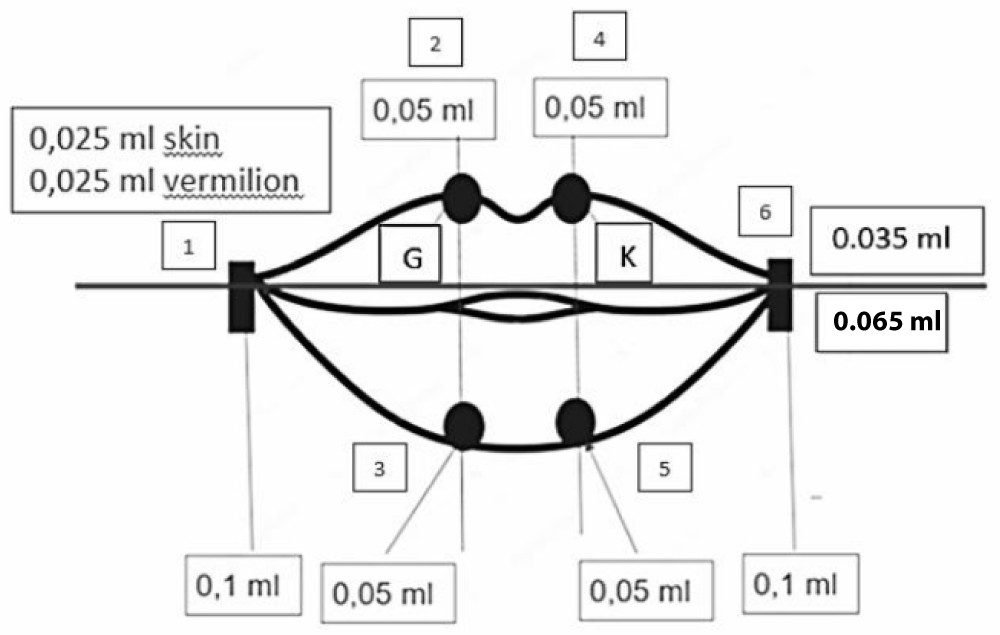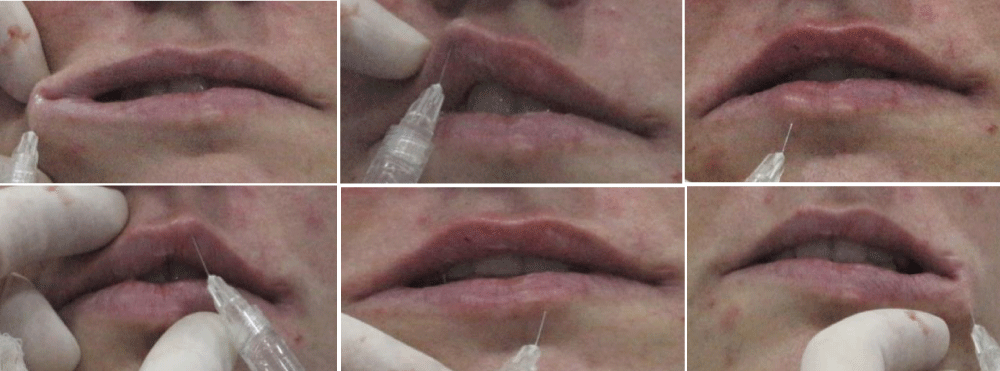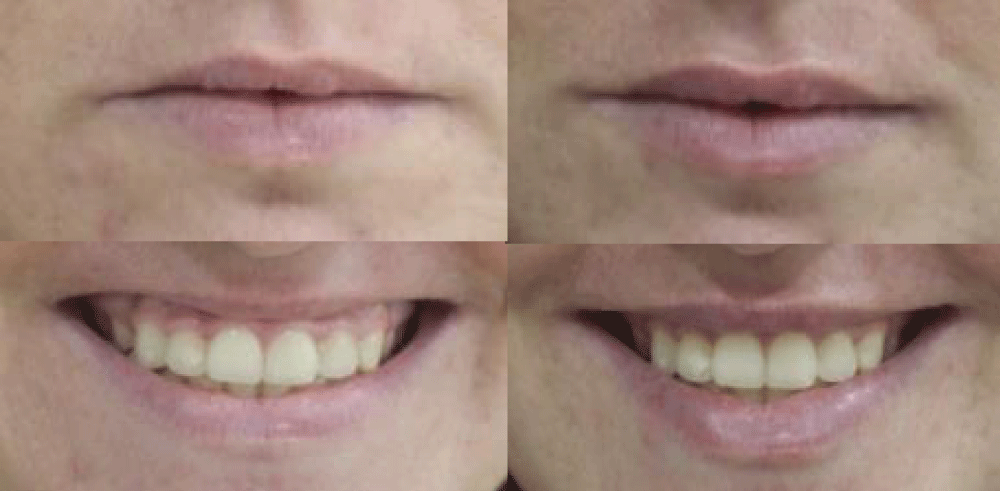More Information
Submitted: April 29, 2022 | Approved: May 06, 2022 | Published: May 09, 2022
How to cite this article: Cymrot N. Lip filler with hyaluronic acid - Light Lips Technique. Ann Dermatol Res. 2022; 6: 010-013.
DOI: 10.29328/journal.adr.1001020
Copyright License: © 2022 Cymrot N. This is an open access article distributed under the Creative Commons Attribution License, which permits unrestricted use, distribution, and reproduction in any medium, provided the original work is properly cited.
Lip filler with hyaluronic acid - Light Lips Technique
Natalia Cymrot*
Natalia Cymrot Private Clinic, São Paulo, Brazil
*Address for Correspondence: Natalia Cymrot, Private Clinic, Avenida Professor, Alfonso Bovero 1057 cj 131 - cep 05019-011, São Paulo - SP - Brazil, Email: [email protected]
The lips and perioral region play an important role in facial aesthetics. Aging induces a loss of volume and contour of the lips, a flattening of the cupid's bow, and the appearance of perilabial wrinkles. Thus, aesthetic procedures are common in this area because fillers can reduce these alterations, improving facial harmony. Although the application of the fillers is based on some systematized framework, undesirable results could occur. The Light Lips Technique is a method that applies a very small amount of small-particle hyaluronic acid, only 0.4 ml, to six specific points of the lips. The objective of the technique is to provide lifting of the labial commissures, highlighting some labial points, such as the Glogau-Klein points of the cupid's bow and its equivalent points on the lower lip. After the application of this technique, it is possible to observe an improvement of the lips with very natural-looking results.
Overall, the lips and the perioral region are very relevant for facial aesthetics, contributing to the communication of human emotions. Although the beautiful and youthful appearance of the lips is subjective and cultural, some features please and attract most people. These characteristics include lip shape, a well-defined cupid`s bow and labial contours, lip volume, straight or slightly elevated commissures, and an ideal distance between the upper lip vermilion apex and the nasal base [1,2].
During the natural aging process, the lips elongate, lose volume and contour, the cupid's bow flattens, commissures suffer deflation and perilabial wrinkles appear. This occurs due to loss of extracellular matrix, elastin, collagen, and subcutaneous tissue, muscle sagging, and bone resorption [3].
Despite the fundamental need for individualization of treatments, considering different facial structures, it is also important that lip filler techniques are somehow systematized, to be safe and reach the desired aesthetic objectives.
This article aims to describe the "Light Lips" Technique, a method of lip filling with a small volume of hyaluronic acid.
Technique description (Figure 2)
In the illustrated cases, small particle hyaluronic acid was used (20 mg/ml - OBT® technology, Restylane Kysse® – Galderma, Uppsala, Sweden), only 0.4 ml, at six distinct points (Figure 1): right and left commissures, with the aim of elevating them, G and K points (Glogau-Klein) of the cupid's bow and its equivalent points on the lower lip. Restylane Kysse® is flexible and firm, and provides good tissue integration and a natural appearance, in an area with a lot of movement, such as the lips. For younger patients, with thicker skin and good bone support, Restylane Lidocaine® (NASHA®) technology would also be indicated, which is even firmer and resistant to deformation forces. Some studies have shown that the application of hyaluronic acid on the lip could last up to one year [4,5]. The literature shows that the risk of allergic reactions with hyaluronic acid is very low [6-8].
Figure 1: Schematic demonstration of Light Lips Technique and volumes applied on each part of the lip.
Figure 2: Light Lips Technique injection demonstration.
Before the procedure, it is important to check the use of anticoagulants, due to the risk of ecchymosis and bruises, to ask the patients about previous or actual infections at the site and the history of cold sores. In these cases, it is important to use antiviral prophylaxis. Previous filler applications and/or the use of permanent products at the application site could entail a risk of complications, thus the patients should be asked about this as well.
Before the procedure, the lips should be anesthetized with a topical anesthetic cream composed of 10% lidocaine and prilocaine 3.5% for 30 minutes. After this, the anesthetic cream must be removed, and the asepsis performed with a 2% chlorhexidine alcohol solution.
With a 4-mm 30-gauge needle, precise placement of the product into the dermis or subcutaneous layer turns the procedure safer. Also, lower pressure is needed to extrude the filler, optimizing the patient`s comfort [9]. This technique aims to increase the safety and predictability of lip augmentation with HA fillers.
The hyaluronic acid should be injected into these six points (Figure 2).
Right and left lip commissures: intradermal plane at each lip corner, 0.1 ml of hyaluronic acid (Restylane® or Restylane Kysse® - Q-Med AB/Galderma, Uppsala, Sweden). This volume should be injected as 0.035 ml superiorly, and 0.065 ml inferiorly to the lip cleft.
The next points are accessed from the vermilion of the upper lip, in the upper direction, to meet points G and K, where 0.05 ml is applied on each side, being 0.025 ml inside the vermilion and 0.025 ml on the skin just above these points.
Finally, the last two sites of application are accessed from the infralabial skin, towards the vermilion, where a perpendicular imaginary line is formed through the points applied to the upper lip. In the intersection of vermilion and the infralabial skin, 0.05 ml should be applied, on each side, but only on the vermilion.
It is important to be careful if a grayish color appears, indicating that the needle is too shallow, which can cause the Tyndall effect [10]. The loss of resistance, on the other hand, may indicate a deepening of the application plan to the subcutaneous cellular tissue.
The most common side effects are ecchymosis, edema, and pain, which usually disappear after 7-10 days, on average. In these cases, ice packs should be applied on the site, beyond sun protection and corrective makeup. The region should not be massaged after application.
Figure 3 shows lips before and after seven days of treatment. The lips are presented with rectified commissures, volume and contours restored, and a more youthful appearance.
Figure 3: Comparison of lip volume and contour before and seven days after application.
Procedures to increase the volume of the lips have been much sought after in recent years. Although the lips can be treated and their aesthetic improvement brings a more jovial appearance, this is one of the treatment areas that cause more concern for patients of all ages because of the fear of unaesthetic and/or artificial-looking results, and they usually decide not to treat their lips.
The "Light Lips" Technique's advantages are:
1. Promotes lip eversion, a delicate central lip projection, and volumization, and reduces the distance between the nose and upper lip. Not filling the entire length of columns of the philtrum, which often becomes unaesthetic, but only its parts close to the G and K points. the ideal distance between the columella and the upper lip vermilion is between 8-12 mm. This distance tends to increase with aging and can be restored with the “Light lips” Technique...The G and K Points could be injected through supralabial skin, as an alternative, which could be less painful but also less precise. In addition, there is the elevation of the labial commissures. All of this promotes natural lip rejuvenation and beauty.
2. It presents the possibility of using a few injection points, consequently reducing pain.
3. The use of very low volumes of hyaluronic acid - only 0.4 ml, in six different points is quite economical. It presents visible results with optimal use of the product, and a good cost-benefit ratio.
Who can benefit from the Light lips Technique?
Both genders, because the favorable lip proportions, like the distance between the columella and superior and inferior vermilion, are relatively similar in men and women [11,12]. A study with 908 caucasian women showed that the ideal ratio of the height of the upper lip vermilion and the upper vermilion skin is 1:1.2 to 2.3 [13,14].
In addition, this technique applies to various age groups, which may have different concerns about the lip region.
In young patients, who prioritize well-defined voluminous and shapely lips, and often do not require much volumization, this technique is useful to highlight points in the central third of the lips.
In middle-aged patients, the "Light Lips" Technique can complement other techniques of contouring, lip eversion, and volumization, correcting the down position of the commissures and also highlighting points in the central third of the lips.
In elderly patients, lip aging occurs due to bone resorption, labial collapse, loss of muscle tone, subcutaneous tissue, and dermal density loss. These changes cause labial collapse, increased distance between the nasal base and upper vermilion (from 12-15 mm to 18-20 mm [6], perioral wrinkles, dehydration, thinning and lateral elongation of the vermilion, flattening of the philtrum, loss of cupid's bow definition and lip contour, loss of lip projection, and deflation of the commissures with the appearance of marionette lines [15-17] to recover their elasticity with filler injection. A larger amount of hyaluronic acid is not indicated for very atrophic lips as this may lead to a "heavy" appearance. In addition, it is a delicate area, where any excess product injected, or an incorrect injection technique may cause unaesthetic results. So, in this group, the "Light Lips" Technique can be used for a delicate and slight improvement of the lips, using a small amount of product. With the increased distance between the nasal base and the upper vermilion in older patients, it may be inappropriate to redo the philtrum columns, since the philtrum may become very visible and unsightly [3]. This technique could improve exactly the beginning of the philtrum columns, near the vermilion, giving a more natural appearance.
Among the main points of the technique described in this article is the volume used in the procedure, which is much lower than with other techniques. The smaller volume brings many advantages, such as the lower risk of extrinsic obstruction of the vessels adjacent to the application, less pain, and lower costs with the procedure, enabling access to more people. On the other hand, if only this volume is used, the duration of the effect can be lower, due because of the degradation of hyaluronic acid by hyaluronidase. Patients should be advised of that possibility.
The most frequent sites of the upper and inferior labial arteries are the submucosal plane (58.5%), intramuscular plane 36.2%), and subcutaneous plane (5.3%) [18]. These results were confirmed by ultrasound analysis that showed that the superior labial artery is at 5.6 ± 0.13 mm from the surface, while the inferior labial artery is less than 5.2 ± 0.14 mm, both located on the vermilion, in the upper lip in 83% of cases and in the lower lip in 86.2% of cases. In the midline, the arteries are in the vermilion in 100% of cases. This study indicates that volumization in superficial planes is safe [19]. Regarding the safety of the injection of commissures, the facial arteries usually are 15 mm laterally to the lip and 11 mm depth in the skin. Therefore, once again the injection by the "Light Lips" Technique is predicted to be safe, being far from these arteries [20].
Despite this, it is important to pay attention to changes in the color of the application region, which may indicate that the application is too superficial and causes the Tyndall effect. The loss of resistance, on the other hand, may indicate a deepening of the application plane to the subcutaneous cellular tissue.
In summary, this technique allows the injection of a minimal amount of hyaluronic acid into the lips presenting an optimized alternative for lip enhancement with a natural look and at a lower cost.
- Gunn DA, Rexbye H, Griffiths CE, Murray PG, Fereday A, Catt SD, Tomlin CC, Strongitharm BH, Perrett DI, Catt M, Mayes AE, Messenger AG, Green MR, van der Ouderaa F, Vaupel JW, Christensen K. Why some women look young for their age. PLoS One. 2009 Dec 1;4(12):e8021. doi: 10.1371/journal.pone.0008021. PMID: 19956599; PMCID: PMC2779449.
- Penna V, Fricke A, Iblher N, Eisenhardt SU, Stark GB. The attractive lip: A photomorphometric analysis. J Plast Reconstr Aesthet Surg. 2015 Jul;68(7):920-9. doi: 10.1016/j.bjps.2015.03.013. Epub 2015 Mar 21. PMID: 25921652.
- Greene RM. Comparing the Use of Injectable Fillers for the Youthful Lip and the More Mature Lip. Facial Plast Surg. 2019 Apr;35(2):134-139. doi: 10.1055/s-0039-1681083. Epub 2019 Apr 3. PMID: 30943557.
- Beer K, Glogau RG, Dover JS, Shamban A, Handiwala L, Olin JT, Bulley B. A randomized, evaluator-blinded, controlled study of effectiveness and safety of small particle hyaluronic acid plus lidocaine for lip augmentation and perioral rhytides. Dermatol Surg. 2015 Apr;41 Suppl 1:S127-36. doi: 10.1097/DSS.0000000000000199. PMID: 25828037.
- Wang F, Garza LA, Kang S, Varani J, Orringer JS, Fisher GJ, Voorhees JJ. In vivo stimulation of de novo collagen production caused by cross-linked hyaluronic acid dermal filler injections in photodamaged human skin. Arch Dermatol. 2007 Feb;143(2):155-63. doi: 10.1001/archderm.143.2.155. PMID: 17309996.
- Friedman PM, Mafong EA, Kauvar AN, Geronemus RG. Safety data of injectable nonanimal stabilized hyaluronic acid gel for soft tissue augmentation. Dermatol Surg. 2002 Jun;28(6):491-4. doi: 10.1046/j.1524-4725.2002.01251.x. PMID: 12081677.
- Artzi O, Loizides C, Verner I, Landau M. Resistant and Recurrent Late Reaction to Hyaluronic Acid-Based Gel. Dermatol Surg. 2016 Jan;42(1):31-7. doi: 10.1097/DSS.0000000000000562. PMID: 26655699.
- Farhi D, Trevidic P, Kestemont P, Boineau D, Cartier H, Bodokh I, Brun P, Ascher B, Savary J; Emervel French Survey Group. The Emervel French survey: a prospective real-practice descriptive study of 1,822 patients treated for facial rejuvenation with a new hyaluronic acid filler. J Drugs Dermatol. 2013 May;12(5):e88-93. PMID: 23652965.
- Walker L, Cetto R. Lip Augmentation Using Hyaluronic Acid Filler and a 4-mm Needle: A Safer, More Natural, and Predictable Approach. J Clin Aesthet Dermatol. 2021 Jan;14(1):E61-E63. Epub 2021 Jan 1. PMID: 33584970; PMCID: PMC7869814.
- Hirsch RJ, Narurkar V, Carruthers J. Management of injected hyaluronic acid induced Tyndall effects. Lasers Surg Med. 2006 Mar;38(3):202-4. doi: 10.1002/lsm.20283. PMID: 16485276.
- Fernández-Riveiro P, Suárez-Quintanilla D, Smyth-Chamosa E, Suárez-Cunqueiro M. Linear photogrammetric analysis of the soft tissue facial profile. Am J Orthod Dentofacial Orthop. 2002 Jul;122(1):59-66. doi: 10.1067/mod.2002.125236. PMID: 12142898.
- Farkas LG, Katic MJ, Hreczko TA, Deutsch C, Munro IR. Anthropometric proportions in the upper lip-lower lip-chin area of the lower face in young white adults. Am J Orthod. 1984 Jul;86(1):52-60. doi: 10.1016/0002-9416(84)90276-8. PMID: 6588760.
- Raphael P, Harris R, Harris SW. Analysis and classification of the upper lip aesthetic unit. Plast Reconstr Surg. 2013 Sep;132(3):543-551. doi: 10.1097/PRS.0b013e31829accb6. Erratum in: Plast Reconstr Surg. 2013 Oct;132(4):1040. PMID: 23985630.
- Chiu A, Fabi S, Dayan S, Nogueira A. Lip Injection Techniques Using Small-Particle Hyaluronic Acid Dermal Filler. J Drugs Dermatol. 2016 Sep 1;15(9):1076-82. PMID: 27602969.
- Rohrich RJ, Ghavami A, Crosby MA. The role of hyaluronic acid fillers (Restylane) in facial cosmetic surgery: review and technical considerations. Plast Reconstr Surg. 2007 Nov;120(6 Suppl):41S-54S. doi: 10.1097/01.prs.0000248794.63898.0f. PMID: 18090342.
- Iblher N, Stark GB, Penna V. The aging perioral region -- Do we really know what is happening? J Nutr Health Aging. 2012;16(6):581-5. doi: 10.1007/s12603-012-0063-7. PMID: 22660001.
- Penna V, Stark GB, Voigt M, Mehlhorn A, Iblher N. Classification of the Aging Lips: A Foundation for an Integrated Approach to Perioral Rejuvenation. Aesthetic Plast Surg. 2015 Feb;39(1):1-7. doi: 10.1007/s00266-014-0415-2. Epub 2014 Nov 20. PMID: 25409624.
- Cotofana S, Alfertshofer M, Schenck TL, Bertucci V, Beleznay K, Ascher B, Lachmann N, Green JB, Swift A, Frank K. Anatomy of the Superior and Inferior Labial Arteries Revised: An Ultrasound Investigation and Implication for Lip Volumization. Aesthet Surg J. 2020 Nov 19;40(12):1327-1335. doi: 10.1093/asj/sjaa137. PMID: 32469050.
- Lee KL, Lee HJ, Youn KH, Kim HJ. Positional relationship of superior and inferior labial artery by ultrasonography image analysis for safe lip augmentation procedures. Clin Anat. 2020 Mar;33(2):158-164. doi: 10.1002/ca.23379. Epub 2019 Apr 15. PMID: 30912205.
- Phumyoo T, Tansatit T, Rachkeaw N. The soft tissue landmarks to avoid injury to the facial artery during filler and neurotoxin injection at the nasolabial region. J Craniofac Surg. 2014 Sep;25(5):1885-9. doi: 10.1097/SCS.0000000000001003. PMID: 25098578.


